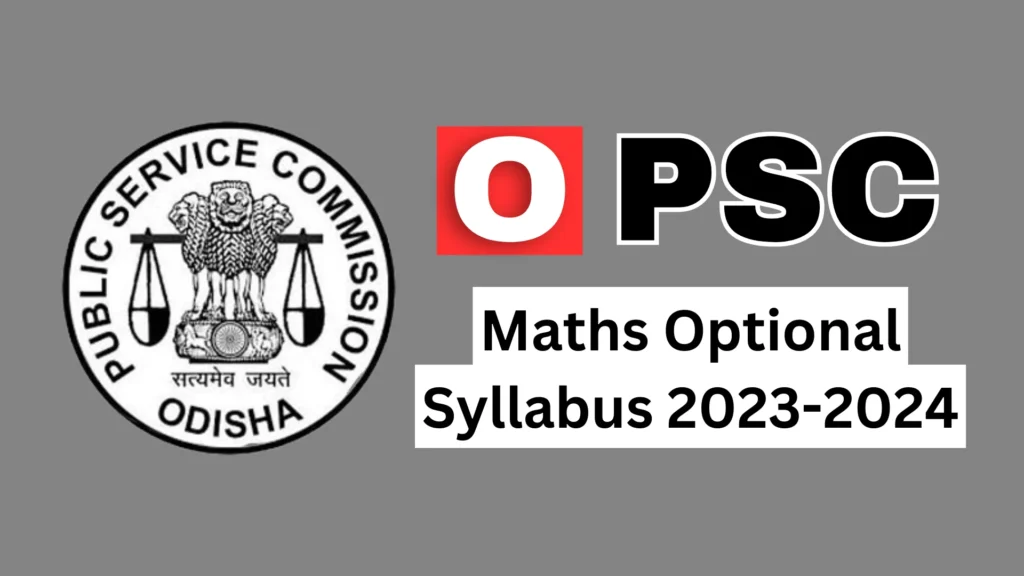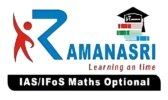
OPSC Civil Services Syllabus 2024
The civil services exam is divided into two phases of preliminary and mains. The OPSC preliminary exam is a two-paper objective exam while the mains has five compulsory and four optional papers. The OPSC Civil Services mains exam also includes an essay paper where the candidates are expected to express their views on a given topic.To excel in the OPSC Civil Services mains exam, you must be very familiar with the OPSC syllabus for the different subjects. Moreover, you must know how to write an essay as the commission will be looking for candidates who can present their ideas in a logical and concise manner. Moreover, you must know the latest developments in the field of your subject as this will be useful for you. Besides, you should also be able to solve problems with ease and accuracy. For this, you should read the current affairs on a daily basis.OPSC Maths Optional Syllabus Paper-1
Section-A
(1) Linear Algebra: Vector spaces over R and C, linear dependence and independence, subspaces, bases, dimensions, Linear transformations, rank and nullity, matrix of a linear transformation. Algebra of Matrices; Row and column reduction, Echelon form, congruence’s and similarity; Rank of a matrix; Inverse of a matrix; Solution of system of linear equations; Eigenvalues and eigenvectors, characteristic polynomial, Cayley-Hamilton theorem, Symmetric, skew-symmetric, Hermitian, skew-Hermitian, orthogonal and unitary matrices and their eigenvalues.
(2) Calculus: Real numbers, functions of a real variable, limits, continuity, differentiability, mean-value theorem, Taylor’s theorem with remainders, indeterminate forms, maxima and minima, asymptotes; Curve tracing; Functions of two or three variables; Limits, continuity, partial derivatives, maxima and minima, Lagrange’s method of multipliers, Jacobian. Riemann’s definition of definite integrals; Indefinite integrals; Infinite and improper integral; Double and triple integrals (evaluation techniques only); Areas, surface and volumes.
(3) Analytic Geometry: Cartesian and polar coordinates in three dimensions, second degree equations in three variables, reduction to Canonical forms; straight lines, shortest distance between two skew lines, Plane, sphere, cone, cylinder, paraboloid, ellipsoid, hyperboloid of one and two sheets and their properties.
Section-B
(4) Ordinary Differential Equations: Formulation of differential equations; Equations of first order and first degree, integrating factor; Orthogonal trajectory; Equations of first order but not of first degree, Clairaut’s equation, singular solution. Second and higher order liner equations with constant coefficients, complementary function, particular integral and general solution. Second order linear equations with variable coefficients, Euler-Cauchy equation; Determination of complete solution when one solution is known using method of variation of parameters. Laplace and Inverse Laplace transforms and their properties, Laplace transforms of elementary functions. Application to initial value problems for 2nd order linear equations with constant coefficients.
(5) Dynamics and Statics: Rectilinear motion, simple harmonic motion, motion in a plane, projectiles; Constrained motion; Work and energy, conservation of energy; Kepler’s laws, orbits under central forces. Equilibrium of a system of particles; Work and potential energy, friction, Common catenary; Principle of virtual work; Stability of equilibrium, equilibrium of forces in three dimensions.
(6) Vector Analysis: Scalar and vector fields, differentiation of vector field of a scalar variable; Gradient, divergence and curl in cartesian and cylindrical coordinates; Higher order derivatives; Vector identities and vector equation. Application to geometry: Curves in space, curvature and torsion; Serret-Frenet’s formulae. Gauss and Stokes’ theorems, Green’s identities
OPSC Maths Optional Syllabus Paper-2
Section-A
1. Numerical Analysis: (i) Interpolation: Lagrange, Newton divided difference forms, Forward and back ward interpolation polynomials. (ii) Approximations: Least squares approximations and curve fitting. (iii) Numerical solution of non-linear equations: Bisection, Secant, Newton Raphson and fixed-point iteration techniques. (iv) Numerical differentiation and integration: Differentiation formulas involving differences, Newton-Cotes rules, Compound rules, Gauss – Legendre 2- and 3-point rules. (v) Numerical solution. of I.V.P.: Euler method, Taylor’s method, Runge-Kutta Method of order two
2. Graph Theory: Simple graphs, Regular, Complete graphs, Bipartite graphs, Matrix representation of graphs, Connected graphs, Isomorphic graphs, Trees, Planar graph, Hamiltonian and Eulerian graphs, Vertex colouring of graphs and Chromatic number.
3. Ordinary and Partial differential equations. (i) Linear first order O.D.E. (ii) Higher order linear differential equations with constant and variable coefficients. (iii) Series solution of O.D.E. (iv) Solution of O.D.E. by Laplace transformation techniques. (v) Solution of equations Pdx + Qdy + Rdz=O and dx/P = dy/Q = dz/R (vi) Charpits method for partial differential equations. (vii) Linear second order P.D.E. and solutions.
Section – B
1. Computer programming: (i) Flow charting and algorithms. (ii) Basics of Fortran language, arithmetic and logical operations, Arithmetic and Logical Statements. (iii) GO TO and Computed GO TO Statements, Arithmetic and Logical IF, IF… THEN…. ELSE Statements, DO Loops. (iv) Arrays and subscripted variables. (v) Functions, Subprograms and Subroutines. (vi) Programme writing in Fortran.
2. Mechanics and Hydrodynamics.
(i) Statics: Law of parallelogram of forces, Equilibrium of forces, Couple and Moments, Frictions.
(ii) Dynamics: Laws of motion, D’ Alembert’s principle, Motion of a particle I in a plane, Projectiles, Motion of rigid bodies, Moment of inertia.
(iii) Hydrodynamics: Equation of continuity, Euler equation of motion (in Cartesian forms) Stream lines, Path Line, Potential flow, Stream functions and Potential functions, Sources, Sinks and Image system with respect to Plane and Circle.
3. Operations Research: (i) Formulation of L.P.P., Graphical solution. (ii) Simplex method and Duality. (iii) Transportation and Assignment problems.
